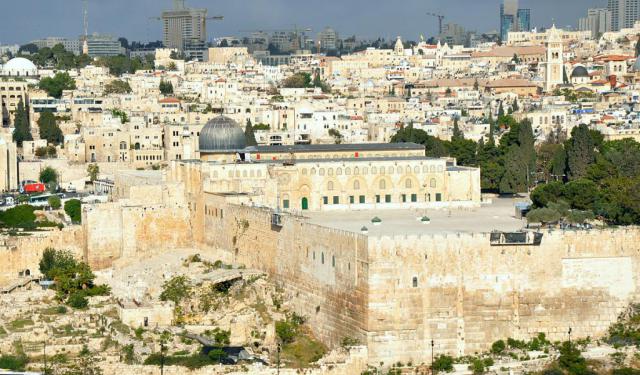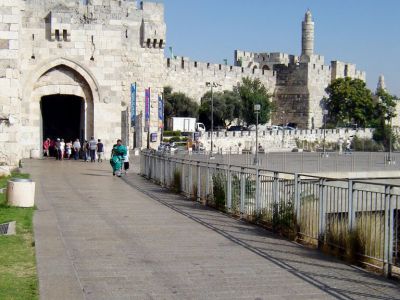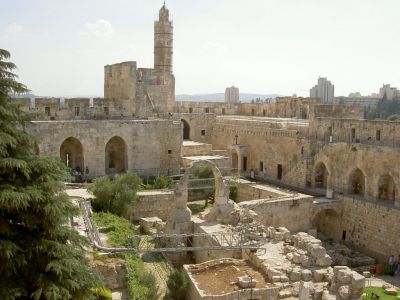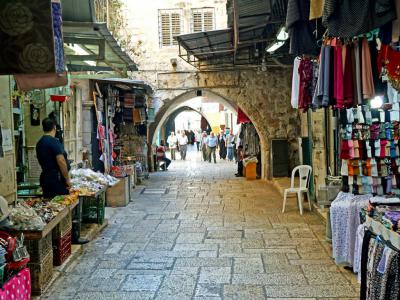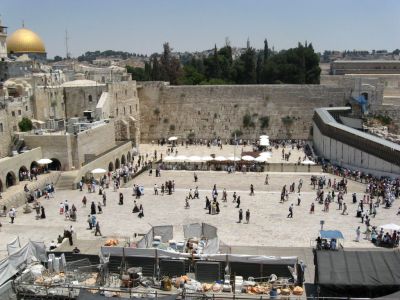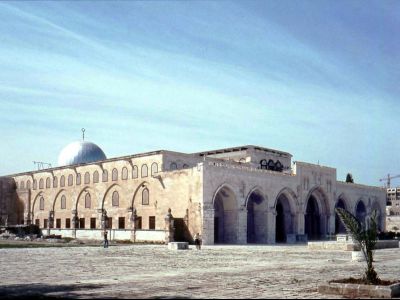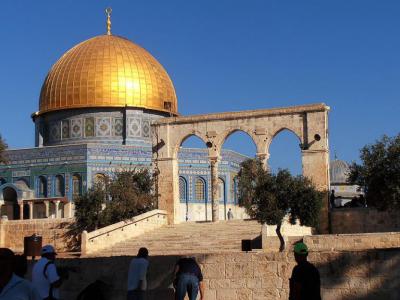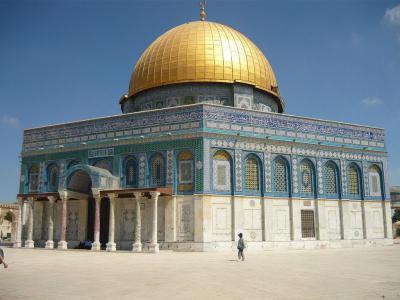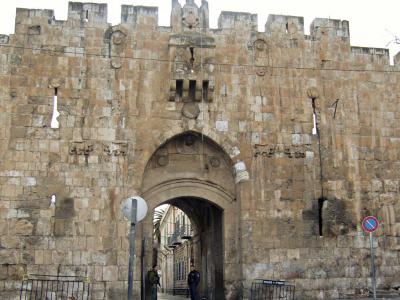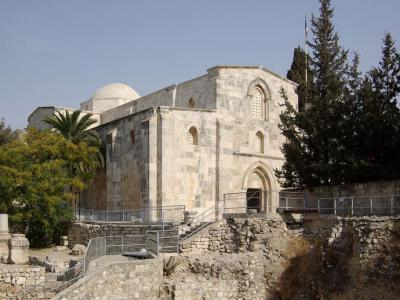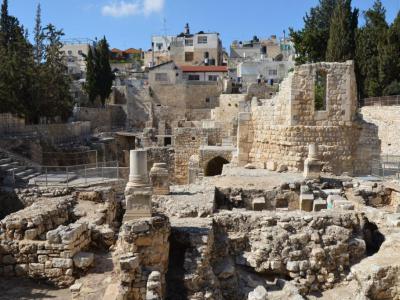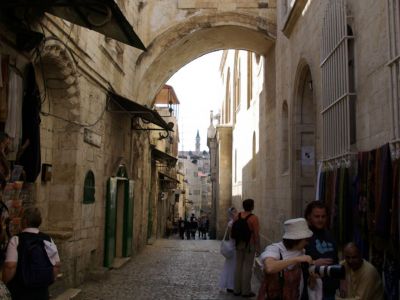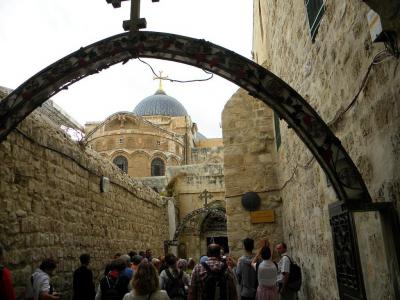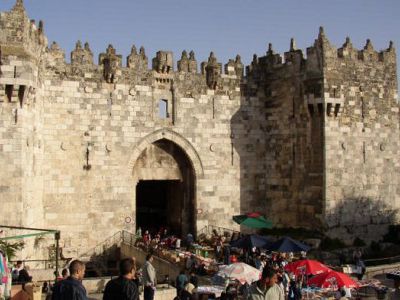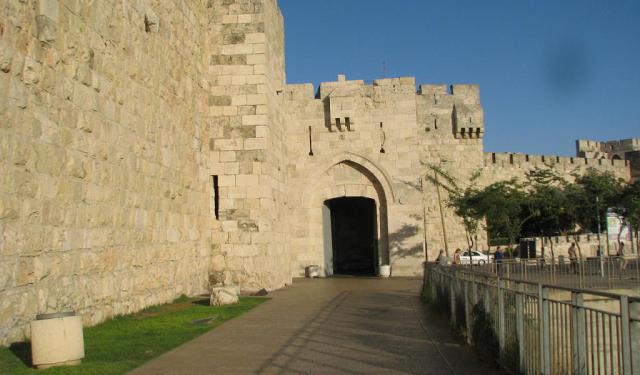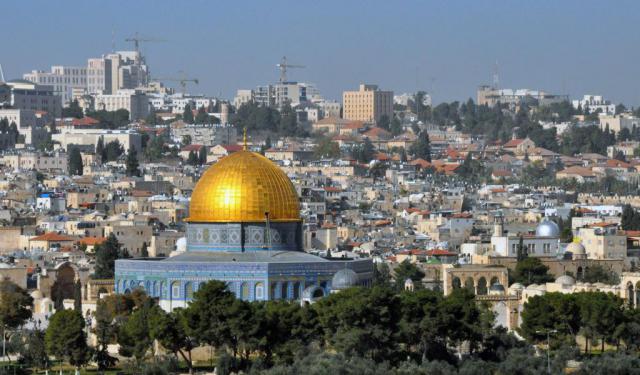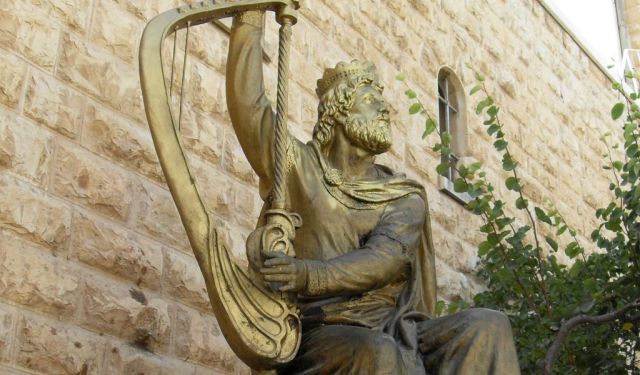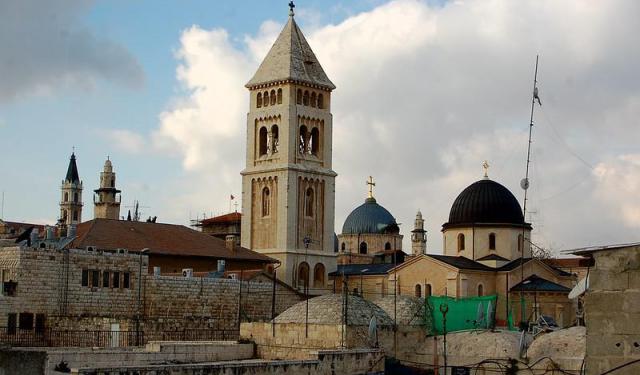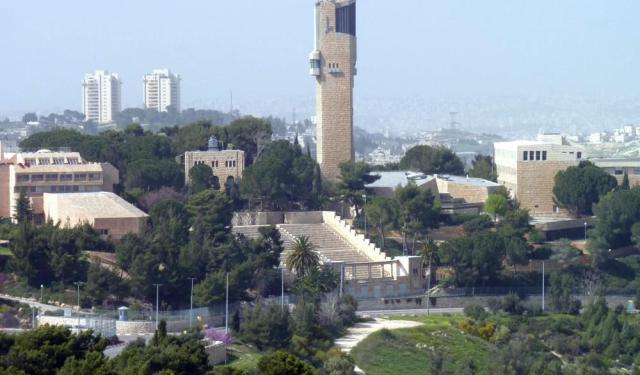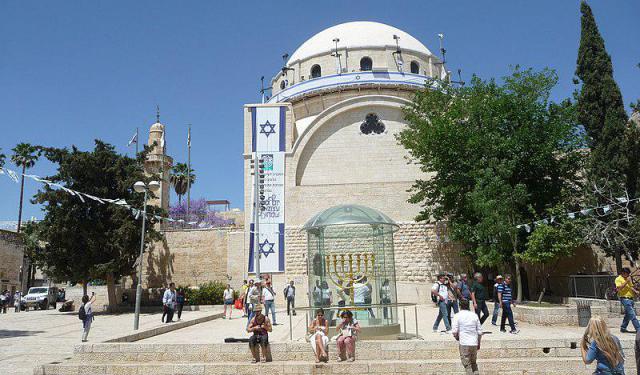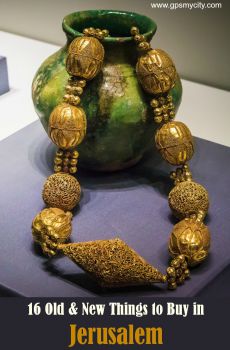Jerusalem Old City Walking Tour (Self Guided), Jerusalem
A UNESCO World Heritage Site since 1981, the Old City of Jerusalem is best explored on foot, since its narrow streets and alleys make it almost an entirely vehicle-free zone. In addition to hosting four ethnic quarters, – Jewish, Muslim, Christian and Armenian – it is packed with major historical and religious sites, which all make a trip here unique, unforgettable and not to be missed.
The area is home to the holiest sites of three Abrahamic religions, namely Judaism’s Western Wall, Islam’s Dome of the Rock and the Church of the Holy Sepulchre. Particularly noteworthy is the Temple Mount, believed to be the site of King Solomon’s Temple, which was completed in 957 BCE and then destroyed by the Babylonians. The mount is extremely important to Muslims because of the present al-Aqsa Mosque – the main place of Islamic worship in Jerusalem. It’s just as much revered by Jews around the world who pray towards the former Solomon Temple’s direction, believing that God’s divine presence is manifested there more than anywhere on earth. Jews also believe that the Third Temple will be built on the Temple Mount before the coming to earth of the future messiah.
The walled city is entered by one of seven entry gates, most convenient of which is the Jaffa Gate. Next to it is the city’s citadel, known as the Tower of David, which not only provides Jerusalem’s history, but also affords full-circle views of its old and new architecture.
Don’t miss a visit to St Anne’s Church – a superb example of Crusader architecture with a grotto underneath, believed to be the birthplace of the Virgin Mary. Near its quiet grounds you’ll find the site of one of Jesus’s miracles – the Pools of Bethesda, as well as the path on which he carried the cross from Pilate's palace to the hill of Golgotha.
Join us on this self-guided orientation walk to be amazed by the key historical sights of Jerusalem’s Old City!
The area is home to the holiest sites of three Abrahamic religions, namely Judaism’s Western Wall, Islam’s Dome of the Rock and the Church of the Holy Sepulchre. Particularly noteworthy is the Temple Mount, believed to be the site of King Solomon’s Temple, which was completed in 957 BCE and then destroyed by the Babylonians. The mount is extremely important to Muslims because of the present al-Aqsa Mosque – the main place of Islamic worship in Jerusalem. It’s just as much revered by Jews around the world who pray towards the former Solomon Temple’s direction, believing that God’s divine presence is manifested there more than anywhere on earth. Jews also believe that the Third Temple will be built on the Temple Mount before the coming to earth of the future messiah.
The walled city is entered by one of seven entry gates, most convenient of which is the Jaffa Gate. Next to it is the city’s citadel, known as the Tower of David, which not only provides Jerusalem’s history, but also affords full-circle views of its old and new architecture.
Don’t miss a visit to St Anne’s Church – a superb example of Crusader architecture with a grotto underneath, believed to be the birthplace of the Virgin Mary. Near its quiet grounds you’ll find the site of one of Jesus’s miracles – the Pools of Bethesda, as well as the path on which he carried the cross from Pilate's palace to the hill of Golgotha.
Join us on this self-guided orientation walk to be amazed by the key historical sights of Jerusalem’s Old City!
How it works: Download the app "GPSmyCity: Walks in 1K+ Cities" from Apple App Store or Google Play Store to your mobile phone or tablet. The app turns your mobile device into a personal tour guide and its built-in GPS navigation functions guide you from one tour stop to next. The app works offline, so no data plan is needed when traveling abroad.
Jerusalem Old City Walking Tour Map
Guide Name: Jerusalem Old City Walking Tour
Guide Location: Israel » Jerusalem (See other walking tours in Jerusalem)
Guide Type: Self-guided Walking Tour (Sightseeing)
# of Attractions: 13
Tour Duration: 3 Hour(s)
Travel Distance: 5.0 Km or 3.1 Miles
Author: vickyc
Sight(s) Featured in This Guide:
Guide Location: Israel » Jerusalem (See other walking tours in Jerusalem)
Guide Type: Self-guided Walking Tour (Sightseeing)
# of Attractions: 13
Tour Duration: 3 Hour(s)
Travel Distance: 5.0 Km or 3.1 Miles
Author: vickyc
Sight(s) Featured in This Guide:
- Jaffa Gate
- The Citadel (Tower of David)
- David Street Arab Market (Shuk)
- Western (Wailing) Wall
- Al-Aqsa Mosque (Masjid al-Aqsa)
- Temple Mount
- Dome of the Rock (Qubbat al-Sakhra)
- Lions' Gate
- Churches of St. Anne
- Pools of Bethesda
- Ecce Homo Arch
- Via Dolorosa (Way of Sorrow)
- Damascus (Shechem) Gate
1) Jaffa Gate
The busiest among the seven gates of the Old City, this serves as the primary entrance for both traffic and pedestrians arriving from modern West Jerusalem via Mamilla. Despite its substantial size, the entrance tunnel is narrow and L-shaped, intentionally designed to impede the progress of attackers. Constructed during the reign of Suleyman the Magnificent, a dedication within the arch on the outside of the gate indicates the exact date of 1538.
Cars can access the Old City through this gate, a privilege attributed to Kaiser Wilhelm II's visit in 1898. Legend has it that the Ottoman authorities, mindful of the belief that every conqueror of the city must enter through here, created a breach in the wall between the gate and the Citadel. This allowed the Kaiser and his entourage to enter through the breach instead of the gate itself, which is on the north side of the breach. However, when General Edmund Allenby captured Jerusalem for the British in 1917, he famously declined to use the Kaiser's breach, opting instead to dismount along with his retinue and enter on foot through the gate, as a sign of respect to the city.
Known as Sha'ar Yafo in Hebrew and Bab al-Khalil in Arabic, the gate offers access to the ramparts, allowing visitors to walk along the city walls. Its various names reflect the diverse perspectives of Jerusalem's inhabitants: the English and Hebrew names allude to the ancient port city of Jaffa on the Mediterranean coast, known as an embarkation point for immigrants, pilgrims, and early tourists, while the Arabic name originates from the holy town of Hebron ("Al-Khalil"), signifying the old road leading to Hebron that commenced at this spot.
Cars can access the Old City through this gate, a privilege attributed to Kaiser Wilhelm II's visit in 1898. Legend has it that the Ottoman authorities, mindful of the belief that every conqueror of the city must enter through here, created a breach in the wall between the gate and the Citadel. This allowed the Kaiser and his entourage to enter through the breach instead of the gate itself, which is on the north side of the breach. However, when General Edmund Allenby captured Jerusalem for the British in 1917, he famously declined to use the Kaiser's breach, opting instead to dismount along with his retinue and enter on foot through the gate, as a sign of respect to the city.
Known as Sha'ar Yafo in Hebrew and Bab al-Khalil in Arabic, the gate offers access to the ramparts, allowing visitors to walk along the city walls. Its various names reflect the diverse perspectives of Jerusalem's inhabitants: the English and Hebrew names allude to the ancient port city of Jaffa on the Mediterranean coast, known as an embarkation point for immigrants, pilgrims, and early tourists, while the Arabic name originates from the holy town of Hebron ("Al-Khalil"), signifying the old road leading to Hebron that commenced at this spot.
2) The Citadel (Tower of David) (must see)
The Citadel adjacent to the Jaffa Gate has been carefully excavated, with each period of its development clearly delineated. Exploring the site, which offers free guided tours in English from Sunday to Friday at 11 AM, may take a couple of hours, particularly if you choose to delve into the museum inside, which narrates the story of Jerusalem and incorporates the archaeological site.
Positioned on the western hill of the Old City, the Citadel has been fortified by rulers of Jerusalem since the 2nd century BC, initially located at the city's northwestern corner and highest point. Herod the Great reinforced the original Hasmonean walls by adding three new towers, one of which, the Phasael, remains standing today. During the Byzantine period, the tower and the Citadel were erroneously identified as the Tower of David, as the Byzantines mistook the hill for Mount Zion, believed to be the site of King David's Palace.
Throughout history, the Citadel underwent various transformations under Muslim and Crusader rule, culminating in its present shape by 1310 under the Mamluk sultan Al-Nasir Muhammad. Suleiman the Magnificent later constructed a square with a monumental gateway in the east, while the prominent minaret, added between 1635 and 1655, became a landmark of Jerusalem.
From the Phasael Tower in the in the Citadel's northeast corner, visitors can enjoy panoramic views of the excavations inside, the Old City outside, and the surrounding landscape to the south and west. Along the ascent, a terrace provides informative plaques identifying the different periods of the remains visible, including part of the Hasmonean city wall, a Roman cistern, and the ramparts of the Umayyad Citadel, which resisted the Crusaders in 1099.
Tip:
A spectacular 45-minute sound-and-light show takes place here every night, but make sure to book early, as it tends to sell out quickly.
Positioned on the western hill of the Old City, the Citadel has been fortified by rulers of Jerusalem since the 2nd century BC, initially located at the city's northwestern corner and highest point. Herod the Great reinforced the original Hasmonean walls by adding three new towers, one of which, the Phasael, remains standing today. During the Byzantine period, the tower and the Citadel were erroneously identified as the Tower of David, as the Byzantines mistook the hill for Mount Zion, believed to be the site of King David's Palace.
Throughout history, the Citadel underwent various transformations under Muslim and Crusader rule, culminating in its present shape by 1310 under the Mamluk sultan Al-Nasir Muhammad. Suleiman the Magnificent later constructed a square with a monumental gateway in the east, while the prominent minaret, added between 1635 and 1655, became a landmark of Jerusalem.
From the Phasael Tower in the in the Citadel's northeast corner, visitors can enjoy panoramic views of the excavations inside, the Old City outside, and the surrounding landscape to the south and west. Along the ascent, a terrace provides informative plaques identifying the different periods of the remains visible, including part of the Hasmonean city wall, a Roman cistern, and the ramparts of the Umayyad Citadel, which resisted the Crusaders in 1099.
Tip:
A spectacular 45-minute sound-and-light show takes place here every night, but make sure to book early, as it tends to sell out quickly.
3) David Street Arab Market (Shuk)
Running downhill from the Jaffa Gate to the Western Wall, David Street is a pedestrian pathway separating the Christian Quarter from the Armenian Quarter. The street's proximity to the Jaffa Gate and its inherent beauty regularly attract a large diverse crowd, including Jews en route to the Western Wall for prayer, Christian pilgrims heading to the Church of the Holy Sepulchre, Muslims ascending to the Temple Mount for prayer, and countless tourists exploring the area.
Too narrow for motor vehicles and with just about enough space to push through an occasional three-wheeled cart, this part of the Old City is a home to the most famous tourist market in Jerusalem, the Arab Market (or "Arab Shuk"), comprising several different sections. The one in the Christian Quarter is mostly tourist-oriented with a major emphasis on Christian-themed gifts. Additionally, there are a few nice bakeries and small supermarkets catering to local residents.
It's important to note that haggling is generally appropriate only for tourist items and household goods. Produce stalls typically have fixed prices, which may be indicated on signs, often in Arabic, and sometimes not written at all. Attempting to haggle over prices at produce stalls is typically seen as amusing at best and potentially offensive at worst to the shopkeepers.
Too narrow for motor vehicles and with just about enough space to push through an occasional three-wheeled cart, this part of the Old City is a home to the most famous tourist market in Jerusalem, the Arab Market (or "Arab Shuk"), comprising several different sections. The one in the Christian Quarter is mostly tourist-oriented with a major emphasis on Christian-themed gifts. Additionally, there are a few nice bakeries and small supermarkets catering to local residents.
It's important to note that haggling is generally appropriate only for tourist items and household goods. Produce stalls typically have fixed prices, which may be indicated on signs, often in Arabic, and sometimes not written at all. Attempting to haggle over prices at produce stalls is typically seen as amusing at best and potentially offensive at worst to the shopkeepers.
4) Western (Wailing) Wall (must see)
The Western Wall – otherwise known as the Wailing Wall, the Place of Weeping, or the Buraq Wall – is part of the last remaining wall of the Temple Mount in Old Jerusalem, and was built in 19 BCE by Herod the Great. The king expanded the Temple Mount area artificially and had the wall built to retain the soil and filler added during that period.
The wall stands about 100 feet high from its foundation, of which only approximately 60 feet are showing above ground. Out of total 45 stone courses laid, only 28 are visible. The first seven layers are dating from the time of Herod the Great, four more layers were added by the Umayyad Caliphate – around 600 CE, and another 14 during the Ottoman period in the 1860s. Finally, the last three layers were added by the Mufti of Jerusalem in the 1920s. No further additions have occurred since the Six-Day War of 1967.
The size of the stones used in the construction is enormous, some weighing between two and eight tons, and one huge stone near Wilson’s Arch weighing alone a staggering 570 tons!!! The amount of effort put into the project of such magnitude is hard to overestimate.
The Wailing Wall has been the site of Jewish pilgrimage and prayer since at least the 300s CE, and is considered to be one of the holiest places for Jews because of its proximity to the Temple Mount. The name “wailing” derives from the Jewish practice of mourning the loss of the Holy Temple on the Temple Mount. The plaza in front of the wall was built after the Six-Day War as a gathering place for worshipers.
Both men and women are allowed to pray at the wall, although they must use separate entrances. The wall is particularly busy at Sabbath which commences at sundown on Friday and lasts until sundown on Saturday. It has now become a tradition to bring to the wall a prayer request written on a small slip of paper to be stuck between the stones. These papers are removed once a month and taken to the Mount of Olives.
Tip:
When visiting, make sure to bring along a valid ID (passport); expect tight security, and dress modestly.
No pictures are allowed during the Sabbath. The entry is free.
The wall stands about 100 feet high from its foundation, of which only approximately 60 feet are showing above ground. Out of total 45 stone courses laid, only 28 are visible. The first seven layers are dating from the time of Herod the Great, four more layers were added by the Umayyad Caliphate – around 600 CE, and another 14 during the Ottoman period in the 1860s. Finally, the last three layers were added by the Mufti of Jerusalem in the 1920s. No further additions have occurred since the Six-Day War of 1967.
The size of the stones used in the construction is enormous, some weighing between two and eight tons, and one huge stone near Wilson’s Arch weighing alone a staggering 570 tons!!! The amount of effort put into the project of such magnitude is hard to overestimate.
The Wailing Wall has been the site of Jewish pilgrimage and prayer since at least the 300s CE, and is considered to be one of the holiest places for Jews because of its proximity to the Temple Mount. The name “wailing” derives from the Jewish practice of mourning the loss of the Holy Temple on the Temple Mount. The plaza in front of the wall was built after the Six-Day War as a gathering place for worshipers.
Both men and women are allowed to pray at the wall, although they must use separate entrances. The wall is particularly busy at Sabbath which commences at sundown on Friday and lasts until sundown on Saturday. It has now become a tradition to bring to the wall a prayer request written on a small slip of paper to be stuck between the stones. These papers are removed once a month and taken to the Mount of Olives.
Tip:
When visiting, make sure to bring along a valid ID (passport); expect tight security, and dress modestly.
No pictures are allowed during the Sabbath. The entry is free.
5) Al-Aqsa Mosque (Masjid al-Aqsa)
Masjid al-Aqsa, meaning "the Farthest Mosque", is simpler and less grandiose compared to the Dome of the Rock. Situated on the Temple Mount, it is believed to occupy the site of the first mosque built in Jerusalem in 638 AD to commemorate Mohammed's "night journey".
Throughout its history, Al-Aqsa has faced destruction and damage from earthquakes and various causes, prompting continuous rebuilding. During the Crusades, it served as the headquarters for the Crusaders, who converted the structure into a church, topping its dome with a cross, while the underground vaults housed Crusader horses, earning them the name Solomon's Stables. The military order of the Knights Templar, founded in 1118, took its name from the complex, which was referred to simply as the Templum by the Crusaders.
Under Saladin' rule, however, the Templar constructions were removed, and the mosque was restored to its original purpose. The mihrab was decorated, and a magnificent cedarwood minbar (pulpit) from Damascus, adorned with ivory and mother-of-pearl, was installed. Despite being destroyed in a fire in 1969, the mosque's beautiful mosaics, rose window, and original columns have endured.
Although much of the mosque's interior dates from the 20th century, it is not less beautiful, including seven aisles, 121 stained-glass windows, and marble columns. Non-Muslims are not permitted to enter without a guide, but they can still appreciate the exterior architecture as part of a visit to the Dome of the Rock.
Throughout its history, Al-Aqsa has faced destruction and damage from earthquakes and various causes, prompting continuous rebuilding. During the Crusades, it served as the headquarters for the Crusaders, who converted the structure into a church, topping its dome with a cross, while the underground vaults housed Crusader horses, earning them the name Solomon's Stables. The military order of the Knights Templar, founded in 1118, took its name from the complex, which was referred to simply as the Templum by the Crusaders.
Under Saladin' rule, however, the Templar constructions were removed, and the mosque was restored to its original purpose. The mihrab was decorated, and a magnificent cedarwood minbar (pulpit) from Damascus, adorned with ivory and mother-of-pearl, was installed. Despite being destroyed in a fire in 1969, the mosque's beautiful mosaics, rose window, and original columns have endured.
Although much of the mosque's interior dates from the 20th century, it is not less beautiful, including seven aisles, 121 stained-glass windows, and marble columns. Non-Muslims are not permitted to enter without a guide, but they can still appreciate the exterior architecture as part of a visit to the Dome of the Rock.
6) Temple Mount (must see)
Known as Al-Haram ash-Sharif ("the Noble Sanctuary") to Muslims, this expansive rectangular esplanade in the southeastern Old City has been a central point of Jerusalem for millennia. According to both Jewish and Muslim traditions, it is the site where Abraham offered his son as a sacrifice to God. Additionally, it is traditionally believed to have housed the First Temple, constructed by Solomon in the 10th century BC and destroyed by the Babylonians in 587 BC. The site was later the location of the Second Temple that succeeded it.
Herod the Great significantly expanded the complex in the 1st century BC, enlarging the Inner Temple and creating the Temple platform by constructing four walls around a natural hill and filling them in. It was from the Second Temple that Jesus is said to have expelled the merchants and moneychangers; however, it was ultimately destroyed by the Romans following a protracted siege of Jerusalem in AD 70, marking the end of the Jewish Revolt. According to historian Josephus, the city was ravaged by murder, famine, and cannibalism.
Although the Dome of the Rock is the most prominent feature on the Temple Mount today, the site encompasses a wealth of other architectural marvels from the Omayyad, Ayyubid, Mameluke, and Ottoman eras, including the Grammar College and numerous madrasas. Visitors should note that certain areas are restricted, particularly the southern portion south of the Gate of the Tribes and the eastern section east of Al-Aqsa. Non-Muslims are only permitted to enter the Temple Mount through Moors' Gate and cannot access the Dome of the Rock and the El-Aqsa Mosque without a guide.
Herod the Great significantly expanded the complex in the 1st century BC, enlarging the Inner Temple and creating the Temple platform by constructing four walls around a natural hill and filling them in. It was from the Second Temple that Jesus is said to have expelled the merchants and moneychangers; however, it was ultimately destroyed by the Romans following a protracted siege of Jerusalem in AD 70, marking the end of the Jewish Revolt. According to historian Josephus, the city was ravaged by murder, famine, and cannibalism.
Although the Dome of the Rock is the most prominent feature on the Temple Mount today, the site encompasses a wealth of other architectural marvels from the Omayyad, Ayyubid, Mameluke, and Ottoman eras, including the Grammar College and numerous madrasas. Visitors should note that certain areas are restricted, particularly the southern portion south of the Gate of the Tribes and the eastern section east of Al-Aqsa. Non-Muslims are only permitted to enter the Temple Mount through Moors' Gate and cannot access the Dome of the Rock and the El-Aqsa Mosque without a guide.
7) Dome of the Rock (Qubbat al-Sakhra)
The Dome of the Rock stands as one of the most magnificent achievements of Islamic architecture, renowned for its golden dome, vibrant blue mosaics, and impeccable proportions. Commissioned by Caliph Abd al-Malik Ibn Marawan, the Dome was intended to assert Islam's significance alongside Judaism and Christianity, particularly in competition with the Church of the Holy Sepulchre.
Contrary to popular misconception, this structure is not a mosque but rather a shrine. It lacks features typical of mosques (such as a qibla wall and prayer hall); instead, it houses a sacred rock believed to be the site where Abraham intended to sacrifice his son. This rock protruded from the remains of Herod's Temple, and Abd al-Malik chose to commemorate it with the construction of the Dome.
The exterior is adorned with marble slabs and glazed green and blue tiles, featuring Koranic inscriptions, geometric patterns, and floral motifs. These designs, originally commissioned by Suleiman the Magnificent in the 1500s, have undergone various renovations over time.
In the 1960s, the dome was covered with anodized aluminum, replacing the original lead covering that had caused structural issues. This aluminum covering provided a lighter and more cost-effective solution compared to the gold that was once used but later melted down to settle the debts of a reckless caliph. Despite these changes, the Dome of the Rock remains an enduring symbol of Jerusalem.
Contrary to popular misconception, this structure is not a mosque but rather a shrine. It lacks features typical of mosques (such as a qibla wall and prayer hall); instead, it houses a sacred rock believed to be the site where Abraham intended to sacrifice his son. This rock protruded from the remains of Herod's Temple, and Abd al-Malik chose to commemorate it with the construction of the Dome.
The exterior is adorned with marble slabs and glazed green and blue tiles, featuring Koranic inscriptions, geometric patterns, and floral motifs. These designs, originally commissioned by Suleiman the Magnificent in the 1500s, have undergone various renovations over time.
In the 1960s, the dome was covered with anodized aluminum, replacing the original lead covering that had caused structural issues. This aluminum covering provided a lighter and more cost-effective solution compared to the gold that was once used but later melted down to settle the debts of a reckless caliph. Despite these changes, the Dome of the Rock remains an enduring symbol of Jerusalem.
8) Lions' Gate
This gate on Jerusalem's eastern ramparts is known by multiple names. While commonly referred to as the Lions' Gate due to the pair of beasts flanking the entrance, it is also called Saint Stephen's Gate after the first Christian martyr who was stoned to death outside the city. His tomb was originally located near the Damascus Gate but was later relocated here for the convenience of Christian pilgrims.
In Arabic, the gate is known as Bab al-Ghor ("Jordan Valley Gate") or "Gate of Our Lady Mary", since the Virgin is believed to have been born just inside. Yet another Arabic name is Meshikuli, which in more modern terms would mean "wicket" – a small opening in a wall – through which, back in the day, people could observe approaching enemies and, in case of attack, pour boiling oil or tar onto their heads.
Legend has it that the emblematic lions flanking the gateway (although one school of thought insists that they are panthers) were originally symbols of the Mamluk sultan Baybars I and were placed there by Suleiman the Magnificent in celebration of his successful campaign to rid the Holy Land of Crusaders. Another story suggests that Suleiman had the panthers installed after dreaming that he would be eaten by lions if he didn't rebuild Jerusalem's ramparts.
Despite its age and historical significance, the Lions' Gate remains remarkably well-preserved, having never undergone restoration. Visitors should be prepared for crowds, particularly on Fridays when Muslims gather for prayer at the nearby Al-Aqsa Mosque.
In Arabic, the gate is known as Bab al-Ghor ("Jordan Valley Gate") or "Gate of Our Lady Mary", since the Virgin is believed to have been born just inside. Yet another Arabic name is Meshikuli, which in more modern terms would mean "wicket" – a small opening in a wall – through which, back in the day, people could observe approaching enemies and, in case of attack, pour boiling oil or tar onto their heads.
Legend has it that the emblematic lions flanking the gateway (although one school of thought insists that they are panthers) were originally symbols of the Mamluk sultan Baybars I and were placed there by Suleiman the Magnificent in celebration of his successful campaign to rid the Holy Land of Crusaders. Another story suggests that Suleiman had the panthers installed after dreaming that he would be eaten by lions if he didn't rebuild Jerusalem's ramparts.
Despite its age and historical significance, the Lions' Gate remains remarkably well-preserved, having never undergone restoration. Visitors should be prepared for crowds, particularly on Fridays when Muslims gather for prayer at the nearby Al-Aqsa Mosque.
9) Churches of St. Anne (must see)
Inside the Lions' Gate, within a walled compound, stand two Churches of Saint Anne, both named after the mother of the Virgin Mary. The Greek Orthodox church, located nearest to the Lions' Gate, features a small cave-like chapel believed by Greek Orthodox tradition to be the site of Mary's birth. Downstairs, visitors can view the tombs of Mary's parents, Saints Anne and Joachim. The church welcomes visitors during specified hours, and a donation is typically expected.
Adjacent to the Greek Orthodox church is the 12th-century Greek Catholic church, open for visitation from Monday to Saturday. Considered one of the simplest yet most beautiful Crusader buildings in the region, it blends Romanesque architecture with Middle Eastern elements such as pointed arches and fluted fringe around the uppermost window (the Crusaders later introduced these very features to Europe). Inside, the unadorned columns and vaulting create a light and airy atmosphere. Due to the perfect acoustics ideal for choral singing, many pilgrim groups visit specifically to experience the remarkable reverberations of hymns sung within.
Descending stairs lead to the ancient crypt with mosaics and columns dating back to Byzantine times, where Catholic tradition places Mary's birth, though priests today refrain from asserting dogma on the matter.
Tips:
An intriguing aspect here is the asymmetrical design, which visitors can observe by counting the number of steps on each side. And, as an extra, there is an extremely beautiful church garden!
Adjacent to the Greek Orthodox church is the 12th-century Greek Catholic church, open for visitation from Monday to Saturday. Considered one of the simplest yet most beautiful Crusader buildings in the region, it blends Romanesque architecture with Middle Eastern elements such as pointed arches and fluted fringe around the uppermost window (the Crusaders later introduced these very features to Europe). Inside, the unadorned columns and vaulting create a light and airy atmosphere. Due to the perfect acoustics ideal for choral singing, many pilgrim groups visit specifically to experience the remarkable reverberations of hymns sung within.
Descending stairs lead to the ancient crypt with mosaics and columns dating back to Byzantine times, where Catholic tradition places Mary's birth, though priests today refrain from asserting dogma on the matter.
Tips:
An intriguing aspect here is the asymmetrical design, which visitors can observe by counting the number of steps on each side. And, as an extra, there is an extremely beautiful church garden!
10) Pools of Bethesda
In the compound housing the Catholic Saint Anne's church, visitors can explore the ruins of the two historic Pools of Bethesda, constructed around 200 BC to supply water to the Temple. According to the Gospel of Saint John, these waters were believed to possess healing properties and were used by Jesus to cure a man who had been afflicted for thirty-eight years.
Excavations reveal the remains of the five porches mentioned in the Gospel, with nearby natural caves adapted as baths for the thousands of sufferers who sought healing during Roman times. Visitors can also observe the remnants of a 3rd-century temple to Serapis built by the Romans on the site, which was later replaced by a basilica during the Byzantine era.
As visitors follow the walkway around the pools, they can descend into the depths of a Roman cistern and explore the various archaeological features, with a detailed plan onsite providing guidance. Additionally, a small museum displays objects found during excavations, although it is typically open only by appointment.
Excavations reveal the remains of the five porches mentioned in the Gospel, with nearby natural caves adapted as baths for the thousands of sufferers who sought healing during Roman times. Visitors can also observe the remnants of a 3rd-century temple to Serapis built by the Romans on the site, which was later replaced by a basilica during the Byzantine era.
As visitors follow the walkway around the pools, they can descend into the depths of a Roman cistern and explore the various archaeological features, with a detailed plan onsite providing guidance. Additionally, a small museum displays objects found during excavations, although it is typically open only by appointment.
11) Ecce Homo Arch
The arch that spans the Via Dolorosa was originally built by the Romans in AD 70 to support a ramp against the Antonia Fortress, where Jewish rebels were barricaded. When the Romans rebuilt Jerusalem in AD 135 following the Second Jewish War, the arch was reconstructed as a monument to their victory. featuring two smaller arches flanking a large central bay. It is this central bay that spans the street just west of the entrance to the Lithostratos ("Pavement of Justice").
One of the side arches is still visible today, integrated into the interior of the neighboring Convent of the Sisters of Zion, which was built in the 1860s. Within the convent lie the remains of the ancient Pool of the Sparrow (Struthion), a reservoir that collected rainwater from rooftops. According to Christian tradition, it was on the stone pavement covering this pool that Pontius Pilate presented Jesus to the crowds, uttering the famous words "Ecce homo" ("Behold the man"). However, archaeological findings date the pavement to the 2nd century AD, during the reign of Hadrian, long after the time of Christ.
Marks scratched into the stone, visible within a railed section, are speculated by historians to have been made by Roman guards as a form of street game. Meanwhile, adjacent to the arch and the Third Station, on the north side of the street, a building belonging to the Greek Orthodox Patriarchate, (though not accessible to the public), bears a plaque identifying it as the Prison of Jesus and Barabas. This tradition was only established in 1911, however, and it is more likely that the structure was a stable associated with the Antonia Fortress.
One of the side arches is still visible today, integrated into the interior of the neighboring Convent of the Sisters of Zion, which was built in the 1860s. Within the convent lie the remains of the ancient Pool of the Sparrow (Struthion), a reservoir that collected rainwater from rooftops. According to Christian tradition, it was on the stone pavement covering this pool that Pontius Pilate presented Jesus to the crowds, uttering the famous words "Ecce homo" ("Behold the man"). However, archaeological findings date the pavement to the 2nd century AD, during the reign of Hadrian, long after the time of Christ.
Marks scratched into the stone, visible within a railed section, are speculated by historians to have been made by Roman guards as a form of street game. Meanwhile, adjacent to the arch and the Third Station, on the north side of the street, a building belonging to the Greek Orthodox Patriarchate, (though not accessible to the public), bears a plaque identifying it as the Prison of Jesus and Barabas. This tradition was only established in 1911, however, and it is more likely that the structure was a stable associated with the Antonia Fortress.
12) Via Dolorosa (Way of Sorrow) (must see)
Via Dolorosa, or "the Way of Sorrow" in Christian tradition, is the path believed to have been taken by Jesus from Pilate's judgment hall to Golgotha, where he was crucified. This route, traversed by countless pilgrims, begins at the Madrasa al-Omariya, located 300 meters west of the Lions' Gate in the Muslim Quarter, and concludes at the Church of the Holy Sepulchre. Along its 500-meter length are the fourteen Stations of the Cross, each commemorating an event in the Gospel narrative. While these stations are a relatively recent addition, with some established only in the 19th century, they are marked by black iron plaques bearing Roman numerals.
One way to ensure finding all fourteen stations and experience the devotional atmosphere is to join the Franciscans' procession. Led by Franciscan friars, who have been appointed guardians of Jerusalem's holy sites since 1342, the procession typically begins at the Umariya School, the First Station of the Cross, on Fridays at 3 PM in winter or 4 PM during daylight saving time, aligning as closely as possible with the time and day of Jesus's original ordeal.
It's important to note that the cobbled stone path can be slippery, especially when wet, and certain sections may have steep inclines with stairs. The area can be crowded and bustling, so visitors should exercise caution and be prepared to move quickly. Consider joining a tour or bringing a comprehensive map or guidebook. Also, have your camera ready! Besides its spiritual significance, the area has impressive artwork and architecture worth exploring.
One way to ensure finding all fourteen stations and experience the devotional atmosphere is to join the Franciscans' procession. Led by Franciscan friars, who have been appointed guardians of Jerusalem's holy sites since 1342, the procession typically begins at the Umariya School, the First Station of the Cross, on Fridays at 3 PM in winter or 4 PM during daylight saving time, aligning as closely as possible with the time and day of Jesus's original ordeal.
It's important to note that the cobbled stone path can be slippery, especially when wet, and certain sections may have steep inclines with stairs. The area can be crowded and bustling, so visitors should exercise caution and be prepared to move quickly. Consider joining a tour or bringing a comprehensive map or guidebook. Also, have your camera ready! Besides its spiritual significance, the area has impressive artwork and architecture worth exploring.
13) Damascus (Shechem) Gate
Easily recognizable as one of the main entrances to the eastern part of Old Jerusalem, this gate stands out due to its monumental size and the constant activity surrounding it. As the most elaborate and fortified among the original seven gates, it features battlements, firing loopholes, and flanking turrets. Back in the day, the large opening above the entrance served to pour boiling oil or projectiles onto would-be invaders. Inside, the gate is designed with a double right-angle turn to further hinder hostile forces.
Named after the Syrian capital located 135 miles (or 220 kilometers) to the north, this structure has remained largely unchanged since its construction between 1537 and 1542 under the direct supervision of Ottoman Sultan Suleyman the Magnificent. Known as Bab el-Amud, or "Gate of the Column", by Arabs, it possibly references a large column topped with a statue of Emperor Hadrian that once stood within.
Built over remnants of the original Roman gate and parts of the Roman city, this gate offers access to archaeological excavations. Outside, steps lead to the excavation site where remnants of a Crusader chapel, a medieval roadway, and signs of the Roman 10th Legion's presence can be found. Further inside, the surviving arch of the Roman gate provides entry to the intriguing Roman Square Excavations. The original Roman plaza, marked with a gaming board engraved in the paving stones, serves as the starting point of the Roman Cardo. One can also observe a hologram depicting Hadrian's column in the main plaza.
Tip:
Starting point for the Ramparts Walk around Jerusalem's, offering routes towards the Lions' Gate in the east or the Jaffa Gate in the west.
Named after the Syrian capital located 135 miles (or 220 kilometers) to the north, this structure has remained largely unchanged since its construction between 1537 and 1542 under the direct supervision of Ottoman Sultan Suleyman the Magnificent. Known as Bab el-Amud, or "Gate of the Column", by Arabs, it possibly references a large column topped with a statue of Emperor Hadrian that once stood within.
Built over remnants of the original Roman gate and parts of the Roman city, this gate offers access to archaeological excavations. Outside, steps lead to the excavation site where remnants of a Crusader chapel, a medieval roadway, and signs of the Roman 10th Legion's presence can be found. Further inside, the surviving arch of the Roman gate provides entry to the intriguing Roman Square Excavations. The original Roman plaza, marked with a gaming board engraved in the paving stones, serves as the starting point of the Roman Cardo. One can also observe a hologram depicting Hadrian's column in the main plaza.
Tip:
Starting point for the Ramparts Walk around Jerusalem's, offering routes towards the Lions' Gate in the east or the Jaffa Gate in the west.
Walking Tours in Jerusalem, Israel
Create Your Own Walk in Jerusalem
Creating your own self-guided walk in Jerusalem is easy and fun. Choose the city attractions that you want to see and a walk route map will be created just for you. You can even set your hotel as the start point of the walk.
Jerusalem City Gates Walking Tour
Historians believe that the Old City of Jerusalem probably came into being more than 4,500 years ago. The defensive wall around it features a number of gates built on the order of the Ottoman sultan Suleyman the Magnificent in the first half of the 16th century, each of which is an attraction in its own right. Until as recently as 1870, they were all closed from sunset to sunrise; nowadays, just... view more
Tour Duration: 2 Hour(s)
Travel Distance: 3.7 Km or 2.3 Miles
Tour Duration: 2 Hour(s)
Travel Distance: 3.7 Km or 2.3 Miles
Muslim Quarter & Temple Mount Tour
The largest, most populous and perhaps most chaotic of all Jerusalem’s quarters, the Muslim Quarter is worth exploring for its unique atmosphere. Spending a day here may take you back to a simpler time, but be prepared for many sights and sounds as you pass many vendors, stores and restaurants on your way from site to site.
Some of the city’s most interesting city gates (Damascus and... view more
Tour Duration: 2 Hour(s)
Travel Distance: 2.1 Km or 1.3 Miles
Some of the city’s most interesting city gates (Damascus and... view more
Tour Duration: 2 Hour(s)
Travel Distance: 2.1 Km or 1.3 Miles
Mount Zion Walking Tour
For those interested in religion and history, Mount Zion offers several unique sights that are situated in close proximity to each other. An important place for Christians, Jews as well as Muslims, it holds important constructions dating from the 20th century as well as a compound built by the Crusaders that marks the spot of both King David’s tomb and the Room of the Last Supper. How... view more
Tour Duration: 1 Hour(s)
Travel Distance: 1.0 Km or 0.6 Miles
Tour Duration: 1 Hour(s)
Travel Distance: 1.0 Km or 0.6 Miles
Christian Quarter Walking Tour
One of the epicenters of worldwide Christianity, the Christian Quarter is the 2nd-largest of Jerusalem’s four ancient quarters. A fascinating place to stroll through, it covers the Old City’s northwestern part, just beyond Jaffa Gate – the traditional pilgrim’s entrance to Jerusalem and a prime destination for most visitors.
With its tangle of broad streets and winding, narrow alleys,... view more
Tour Duration: 1 Hour(s)
Travel Distance: 1.1 Km or 0.7 Miles
With its tangle of broad streets and winding, narrow alleys,... view more
Tour Duration: 1 Hour(s)
Travel Distance: 1.1 Km or 0.7 Miles
Mount Scopus Walking Tour
Dotted with many sightseeing places, Mount Scopus – translating as the “Observation Mount” from Greek – is a great place to get views over the whole Old City of Jerusalem on a nice day. The mount has been of major strategic importance since Roman times, with forces setting up camp here prior to laying the siege that culminated in the final Roman victory over Jerusalem around 70 AD.... view more
Tour Duration: 1 Hour(s)
Travel Distance: 2.3 Km or 1.4 Miles
Tour Duration: 1 Hour(s)
Travel Distance: 2.3 Km or 1.4 Miles
Jewish Quarter Walking Tour
Entirely rebuilt in the 1980s after having been largely destroyed during the 1948 War, the Jewish Quarter is quite distinct from the rest of the Old City. Good signposting, spacious passageways, art galleries and a somewhat less buzzing atmosphere make the area a relaxing place to spend some time.
With its rebuilt residential buildings, some almost consider this area the "New... view more
Tour Duration: 1 Hour(s)
Travel Distance: 1.3 Km or 0.8 Miles
With its rebuilt residential buildings, some almost consider this area the "New... view more
Tour Duration: 1 Hour(s)
Travel Distance: 1.3 Km or 0.8 Miles
Useful Travel Guides for Planning Your Trip
16 Uniquely Israel Things to Buy in Jerusalem
Modern day Jerusalem is a mosaic of neighborhoods, reflecting different historical periods, cultures, and religions. The influx of repatriates in recent years has made the cultural and artisanal scene of the city even more colourful and diverse. To find your way through Jerusalem's intricate...
The Most Popular Cities
/ view all
